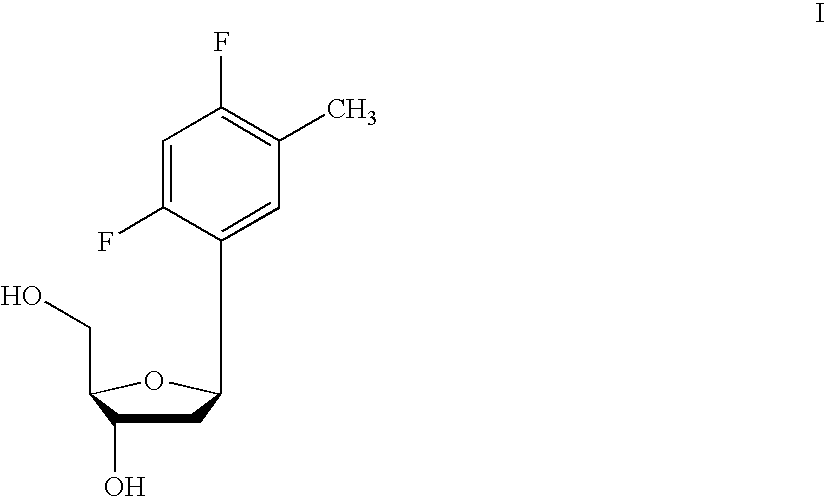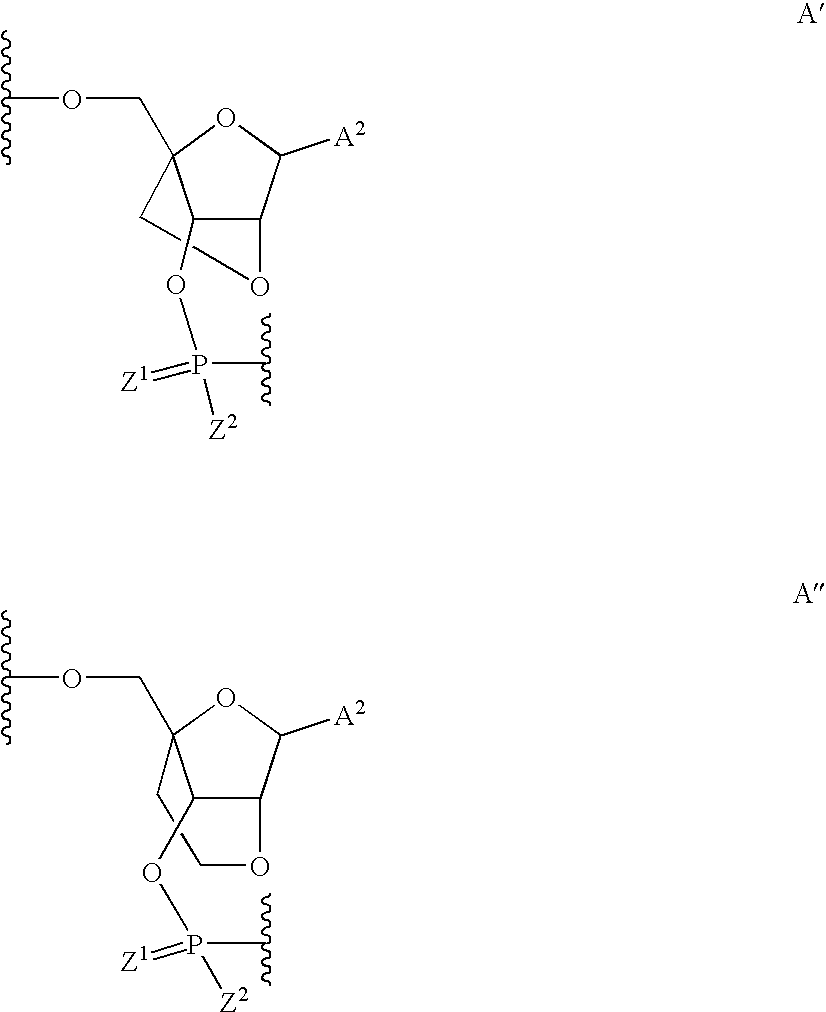Oligonucleotides comprising a modified or non-natural nucleobase
a technology of nucleotide and nucleotide sequence, which is applied in the field ofoligonucleotides comprising a modified or non-natural nucleobase, can solve the problems of poor serum solubility of oligonucleotide sequence, poor cellular distribution and uptake, and rapid excretion, etc., and achieves the effect of reducing the number of oligonucleotide sequences and reducing the number of oligonucleo
- Summary
- Abstract
- Description
- Claims
- Application Information
AI Technical Summary
Problems solved by technology
Method used
Image
Examples
example 1
Synthesis of 5′-O-(4,4′-dimethoxitrityl)-2′-O-(tert-butyldimethylsilyl)-1′-(2,4-difluorotoluene)-D-riboside-3′-O-cyanoethyl-N,N-diisopropylphosphoramidate and 5′-O-(4,4′-Dimethoxitrityl)-3′-O-(tert-butyldimethylsilyl)-1′-(2,4-difluorotoluene)-D-riboside-2′-O-cyanoethyl-N,N-diisopropylphosphoramidate
[0633]
General Procedures
[0634] TLC was conducted on glass plates precoated with a 0.25-mm layer of Silica Gel 60 F-254 (Merck analysis). The compounds were visualized either by exposure to UV light or by spraying with 5% H2SO4, and 0.2% p-anisaldehyde in a solution of ethanol and heating or both. Solutions were concentrated under reduced pressure at 1H-NMR spectra were recorded at 30° C. with 400 MHz spectrometer. The values of δ (ppm) are given relative to the signal (δ0) for internal Me4Si for solutions in CDCl3, CD3OD, and DMSO-d6. 13C-NMR spectra were recorded at 303.0 K with a 400.0 MHz or 500 MHz spectrometer using CDCl3 (77.0 ppm), CD3OD (49.15 ppm), and DMSO-d6 (39.5 ppm) as re...
example 2
Synthesis of solid supports of 2,4-difluorotoluene-D-riboside and its analogues
[0649]
Step A: Succinate of 2′-hydroxyl or 3′-hydroxyl of 5′-O-(4,4′-dimethoxitrityl)-1-C-2,4-difluorotoluene-D-riboside
[0650] Succinic anhydrous (53 mg, 0.36 mmol) was added to a solution of a mixture of 2′-OTBDMS or 3′-O-TBDMS of 5′-O-(4,4′-Dimethoxitrityl)-1-C-(2,4-difluorotoluene)-D-δ-ribofuranoside (240 mg, 0.36 mmol), and DMAP (53 mg) in dry dichloromethane (2-3 mL). The reaction mixture was stirred at room temperature under an agorn atmosphere for 6 h. Another portion of succinc anhydrous (18 mg) and DMAP (14 mg) were added and stirred for a total of 16 h. The mixture was concentrated to a crude residue which was dissolved in ethyl acetate (50 mL), washed with citric acid (400 mg / 20 mL), brine, and dried (Na2SO4). The organic layer was concentrated to a crude residue (330 mg) and dried for next reaction without purification and identification.
Step B: Solid supports of 2′-hydroxyl or 3′-hydroxyl o...
example 3
Design and Synthesis of Novel Phosphoramidites of 1-N-Methylpseudouridine and Analogues
[0652]
Synthesis of 5′-O-(4,4′-dimethoxitrityl)-2′-O-(tert-butyldimethylsilyl)-1-N-methylpseud-uridine-3′-O-cyanoethyl-N,N-diisopropylphosphoramidate
Step A: 1-Methylpseudouridine.
[0653] The title compound was prepared according to published procedure (Matsuda, A. et al., J. Org. Chem. 1981, 46, 3603-3609) and resulted in a pure compound (2.5 g, 84%) as an amorphous solid. 1H-NMR (DMSO-d6, 400 MHz): δ 11.33(s, 1H, NH), 7.73 (s, 1H, H-6), 4.93 (d, 1H, J=5.2 Hz, H-1′), 4.78 (dd, 1H, J=5.2, J=6.6 Hz), 4.73 (d, 1H, J=6.0 Hz), 4.44 (d, 1 H, J=4.8 Hz), 3.92 (dd, 1H), 3.86 (dd, 1H), 3.70-3.67 (m, 1H), 3.62-3.57 (dq, 1H), 3.48-3.42 (m, 1H), 3.21 (s, 3H, CH3).
Step B: 5′-O-(4,4′-Dimethoxitrityl)-1-N-methylpseudouridine
[0654] 4,4′-Dimethoxtrityl chloride (437 mg, 1.29 mmol) was added to a solution of 1-N-methylpseudouridine (300 mg, 1.16 mmol) in dry pyridine (3 mL) in the presence of 4-N,N-dimethylaminop...
PUM
| Property | Measurement | Unit |
|---|---|---|
| Temperature | aaaaa | aaaaa |
| Temperature | aaaaa | aaaaa |
| Temperature | aaaaa | aaaaa |
Abstract
Description
Claims
Application Information
 Login to View More
Login to View More - R&D
- Intellectual Property
- Life Sciences
- Materials
- Tech Scout
- Unparalleled Data Quality
- Higher Quality Content
- 60% Fewer Hallucinations
Browse by: Latest US Patents, China's latest patents, Technical Efficacy Thesaurus, Application Domain, Technology Topic, Popular Technical Reports.
© 2025 PatSnap. All rights reserved.Legal|Privacy policy|Modern Slavery Act Transparency Statement|Sitemap|About US| Contact US: help@patsnap.com



